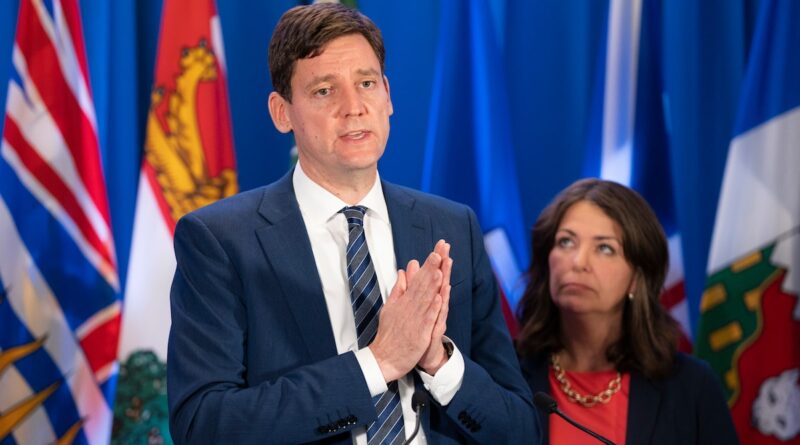Globe article: Enough with the health care gimmicks
British Columbia Premier David Eby speaks to reporters with Alberta Premier Danielle Smith during a meeting with other Canadian premiers at the Federation Council meeting in Halifax on July 16.Darren Calabrese/Canadian Journalist
There is an immutable law of health care physics in Canada: for every modest proposal for change there must be an immediate explosion of fear.
So to British Columbia, where the Conservative Party is starting (unrelated to its government names) has released its health care plan, proposing changes that were simple, bordering on shy people. That didn’t stop the BC NDP from asserting that Conservative Leader John Rustad is out to destroy the province’s health care system.
“I heard an announcement from John Rustad that if he is elected premier, BC Conservatives are elected to government, that he will cut $4-billion from our health care system,” Premier David Eby told reporters during a press conference. press release in mid-July. Later, in a provincial radio program, the Prime Minister confirmed that, “It was there in black and white.”
None of that is true. The Conservative health care plan is not about $4 billion, black, white or otherwise. (Actually, no cost — an unforced error that opened the door to the NDP’s misinformation.)
However, it cites a report from Deloitte Canada that discusses broad trends to include increases in health care spending over the next decade and a half.
Clearly, the report is not a document to take a meat cleaver to health care budgets. The consultancy describes a scenario in which the development of public health care results in a success that reduces the share of gross domestic product spent on health care in 2040 to 11 percent from 14.9 percent (and the current 12.4 percent).
Am I cut? In fact, since the economy will be growing by then: 11 percent of the very large economy of 2040 will be in dollars, more than the current currency. Even an average growth rate of just 1 percent would mean that costs by 2040 were higher – just not as high as if health care costs were not restricted.
From there, the NDP asserts that the Conservatives intend to cut $4 billion in health spending in their first year in office, an argument that is plainly absurd.
If New Democrats are concerned that the government is planning to reduce the share of GDP spent on health care, they might want to look at their budget. The government’s budget plan shows a slower rate of growth in spending, enough for the share of GDP spent on health care to fall over the next two years — the same charge the NDP made against the Conservatives.
In the interview, NDP MLA Ravi Parmar noted that his government has already increased health spending significantly. And he said that the government will present other health care promises during the autumn election campaign, and that the emergency fund of the budget can be used for health care. Also, previous NDP estimates have added new spending over the same estimates.
However, until then, the NDP’s plan is to reduce health care spending as a percentage of GDP – it’s there in black and white, according to Mr. Eby.
All this highlights the fundamental folly of measuring the performance of the health system only by the number of dollars poured into it. One would hope that if technology or other changes reduce costs without compromising service levels, any political party will be happy to be saved. And one would hope that political parties would debate the changes on their merits instead of panicking about cuts.
There are some Conservative proposals (some of which were previously outlined by right-wing rivals, BC United) that are worth discussing, if only as a prelude to greater change.
The Conservatives, for example, want to move away from funding for hospitals to a fee-for-service model. Such a step is promising and can direct attention to hospitals to reduce administrative costs, as well as to create an apples-to-apples ratio for private services that perform publicly paid procedures.
Similarly, both BC United and the Conservatives are proposing greater use of private services to clear the backlog in the health care system.
The NDP went the other way, buying private utilities. Which method will provide the fastest care at the lowest cost? That is a conversation that needs to be had during the provincial election.
But that will require the parties to agree on their proposals rather than trying to end the debate through creative – and sadly predictable – fearmongering.
#Globe #article #health #care #gimmicks
